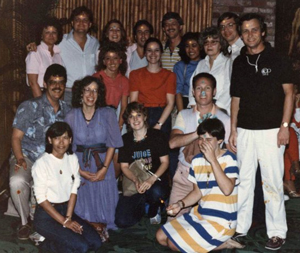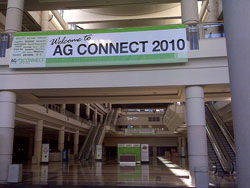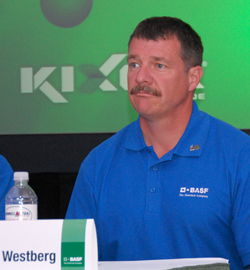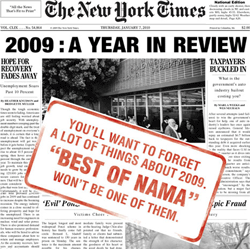 I am really looking forward to heading for the blue skies of Seattle this weekend for the American Farm Bureau Federation’s 91st annual meeting.
I am really looking forward to heading for the blue skies of Seattle this weekend for the American Farm Bureau Federation’s 91st annual meeting.
I do have a special place in my heart for Farm Bureau, since that is where I started my life in agricultural communications. I interned at Florida Farm Bureau while I was still in college at the University of Florida back in 1980 and was hired on full time when I graduated by Gary Cooper of Southeast Agnet who was broadcast manager there at the time. After a brief detour to Maryland, Chuck and I both worked there from 1983-1985.
 One of my most memorable AFBF conventions was 1985 in Hawaii, when this group photo was taken. You might recognize a few of the folks in the picture. It was lots of fun, but also lots of work. I remember it as the first “multi-media” event coverage I ever did. Chuck was doing video for AFBF and I was the only one covering the event for Florida. I filed radio reports, did press releases, shot and edited a TV story, took slides and wrote stories for the magazine.
One of my most memorable AFBF conventions was 1985 in Hawaii, when this group photo was taken. You might recognize a few of the folks in the picture. It was lots of fun, but also lots of work. I remember it as the first “multi-media” event coverage I ever did. Chuck was doing video for AFBF and I was the only one covering the event for Florida. I filed radio reports, did press releases, shot and edited a TV story, took slides and wrote stories for the magazine.
Another memorable one was 1992 in Kansas City, right after we moved to Missouri to work for Brownfield Network. President Bush spoke at that meeting and I anchored a live broadcast of that speech with Lynn Ketelsen, who was president of NAFB at the time.
I will be heading to Seattle on Saturday as the event officially gets underway on Sunday. If you will not be attending, keep an eye on Agwired for all the happenings.
 Monsanto and the American Farm Bureau Federation will host two “tweetups” for Twitter users in the Monsanto booth during the AFBF annual meeting which starts Sunday in Seattle.
Monsanto and the American Farm Bureau Federation will host two “tweetups” for Twitter users in the Monsanto booth during the AFBF annual meeting which starts Sunday in Seattle.  The Tweetups will be held at the Exhibitor Showcase in the Monsanto Booth #210. First one is Sunday at 3 pm, then they will do it again on Monday at 8 am. Come learn about the usefulness of Twitter and network with some of the agricultural leaders advocating for the industry online. Non-Twitter users are also encouraged to come and find out what it’s all about!
The Tweetups will be held at the Exhibitor Showcase in the Monsanto Booth #210. First one is Sunday at 3 pm, then they will do it again on Monday at 8 am. Come learn about the usefulness of Twitter and network with some of the agricultural leaders advocating for the industry online. Non-Twitter users are also encouraged to come and find out what it’s all about! 
 It looks like AgWired sponsor,
It looks like AgWired sponsor, 
 AG CONNECT is in action as setup has been underway for a couple days now in Orlando, FL. You can see photos in the official
AG CONNECT is in action as setup has been underway for a couple days now in Orlando, FL. You can see photos in the official 
 Next week we’re going to have an “A” class tweetup. It’s an AGCO/AEM/AgChat Tweetup at
Next week we’re going to have an “A” class tweetup. It’s an AGCO/AEM/AgChat Tweetup at  One of my most memorable AFBF conventions was 1985 in Hawaii, when this group photo was taken. You might recognize a few of the folks in the picture. It was lots of fun, but also lots of work. I remember it as the first “multi-media” event coverage I ever did. Chuck was doing video for AFBF and I was the only one covering the event for Florida. I filed radio reports, did press releases, shot and edited a TV story, took slides and wrote stories for the magazine.
One of my most memorable AFBF conventions was 1985 in Hawaii, when this group photo was taken. You might recognize a few of the folks in the picture. It was lots of fun, but also lots of work. I remember it as the first “multi-media” event coverage I ever did. Chuck was doing video for AFBF and I was the only one covering the event for Florida. I filed radio reports, did press releases, shot and edited a TV story, took slides and wrote stories for the magazine.  Gary Truitt with Hoosier Ag Today recently published an article titled,
Gary Truitt with Hoosier Ag Today recently published an article titled,  Okay, so it’s snowing in Kansas City now. But the show will still go on tomorrow. That’s the Region 2 Best of NAMA. Are you going to a regional best?
Okay, so it’s snowing in Kansas City now. But the show will still go on tomorrow. That’s the Region 2 Best of NAMA. Are you going to a regional best?